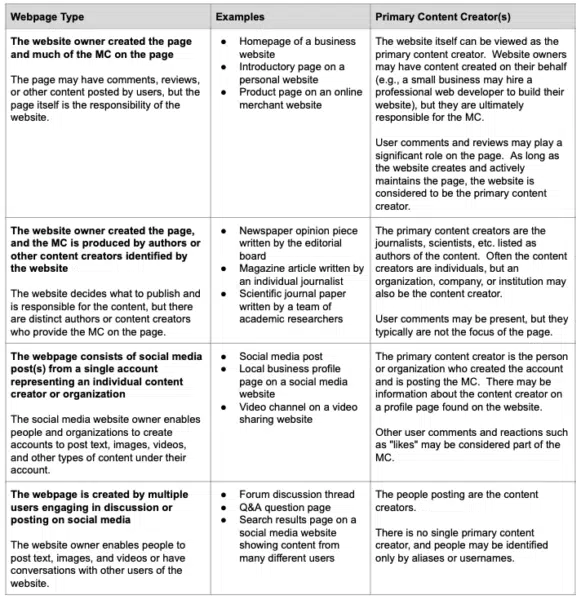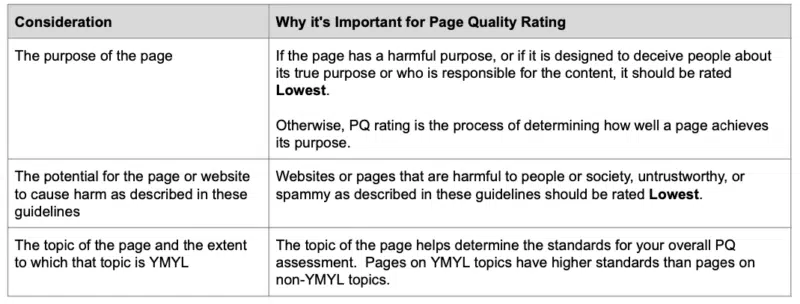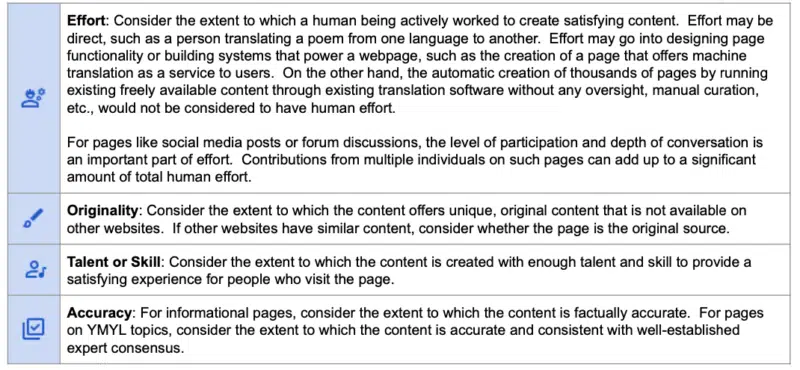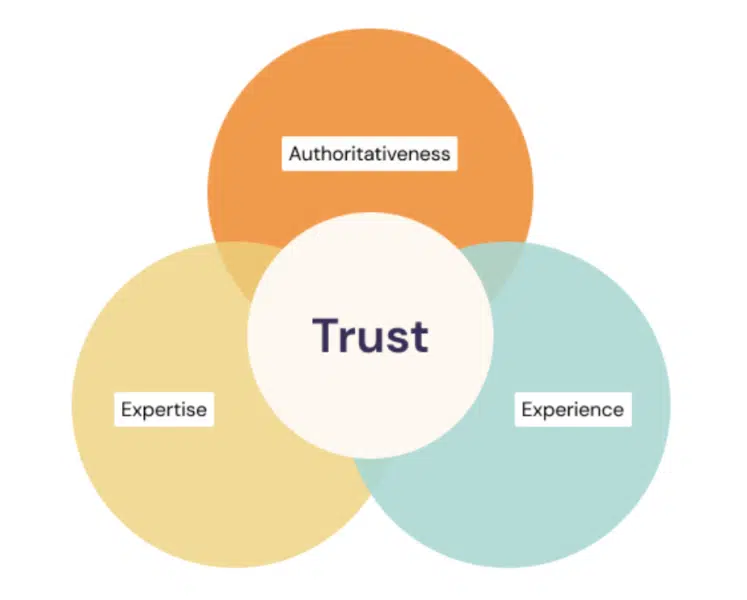E-E-A-T and major updates to Google’s quality rater guidelines
The most important change to the QRG is the introduction of the letter E to the start of the popular acronym E-A-T.
Google has made significant changes to its Quality Rater Guidelines (QRG) for search.
While Google updates this document several times per year, the latest version, updated today, came with notable changes to the structure of the document, with many new sections and tables added and a total of 11 new pages worth of content.
While there are dozens of important details about what changed, arguably the most important change was the introduction of the letter E to the start of the popular acronym E-A-T.
Introducing E-E-A-T
Google is now introducing the concept of E-E-A-T, which stands for
- Experience.
- Expertise.
- Authoritativeness.
- Trustworthiness.
The addition of “experience” indicates that content quality can also be evaluated through the lens of understanding the extent to which the content creator has first-hand experience in the topic.
With this reframing of E-E-A-T, Google also states that “trust” is at the center of this concept and is the “most important member of the E-E-A-T family.”
Google also provides many more clear examples of important concepts, such as:
- Evaluating the reputation of websites and content contributors.
- The extent to which E-E-A-T matters and how it should be evaluated.
- What it means for content to be harmful.
More inclusive language and granularity
Google appears to be evolving its language to be more inclusive and keep up with the times. It added many new mentions of social media platforms, influencers, and how content can take different forms, such as video, UGC, and social media posts.
In this version, Google also takes a granular approach in answering many common questions about how E-E-A-T works and how much it matters for different topics. Google spells out what content should be considered harmful and whether everyday experience is sufficient to produce trustworthy content for the topic at hand.
There are many more changes than what is outlined below.
All SEOs should take time to read through Google’s new guidelines, as they serve as a representation of where Google wants its algorithms to go.
The most significant changes to the QRG
Below are some of the most significant changes to the Search Quality Guidelines in December 2022, broken down by section.
Understanding the Website – Section 2.5
Google updated its guidelines around identifying who operates a website. In the new QRG, Google added the following new guidance:
“Start by finding out who is responsible for the website and who created the content on the page… Then, look for information about the website and/or content creators on the website itself.” (page 15)
This addition implies that it’s important to know who actually owns and operates the website, even if that relationship is not directly clear on the site.
Google also began to refer to the reputation of the “website and/or content creators” instead of just the website, indicating that the reputation of the people contributing content to the website should also factor into consideration when evaluating that website.
Finding Who is Responsible for the Website and Who Created the Content on the Page – Section 2.5.2
When identifying who is responsible for a website, Google states it should be clear who owns the website.
In the previous version of the QRG, Google asked raters to look for which “individual, company, business, foundation, etc.” is responsible for the site.
In this version, Google replaced “foundation” with “organization” and “government agency.”
Google also added:
“…for pages on websites such as forums and social media platforms, people may post content using an alias or username in order to avoid sharing personally identifiable information online. In these cases, the alias or username is an acceptable way to identify the content creator.”
Google also added a brand new table to help quality raters identify who created the main content on a webpage.

This table helps raters identify who is responsible for the content on various types of sites, given that some websites entirely control their own content, while others are comprised primarily of user-generated content or contributions from authors.
Google seems to be focused on distinguishing the website owner from the content contributor(s) on that site.
Overall Page Quality Rating – Section 3.0
Google significantly shifted around the order of some of its advice related to rating page quality and analyzing reputation information.
The updated QRG offers a new 3-step process for assessing Page Quality:
- Assessing the true purpose of the page and how harmful/deceptive it is
- Assessing the potential of the page to cause harm or otherwise be untrustworthy or spammy
(If the rater determines the pages are harmful, untrustworthy or spammy, they should rate them Lowest quality)
- If the page is not harmful, the quality rating is based on how well the page achieves its purpose
Google also added a new table to consider when evaluating page quality:


The third consideration asks the rater to consider the “extent to which the topic of the page is YMYL.” This refers to the spectrum of YMYL topics referenced in the previous version (based on their ability to cause harm to the user).
Google introduced a new consideration for understanding the type of website. Some of these considerations include whether the website:
- Is a hobbyist site or corporate.
- Involves financial transactions or requires payments
- Is supported by volunteers or by professionals.
Different types of websites have different page quality expectations
Google also indicated that while ads are necessary for many sites to monetize, the “ways in which ads contribute to user experience” are a consideration for page quality.
As stated in previous sections, the reputation of the website and its content creators contributes to page quality.
And lastly, we have the most significant reveal of the updated Quality Rater Guidelines: E-E-A-T: Experience, Expertise, and Authoritativeness and Trust.
Quality of the Main Content – 3.2
Google made some important changes to how raters should assess the quality of a page’s main content.
In the previous version (page 24), Google stated:
“For all types of webpages, creating high quality MC takes a significant amount of at least one of the following: time, effort, expertise, and talent/skill.”
In the new version (page 22), Google removed the word “time” and added the word “originality.”
“For most pages, the quality of the MC can be determined by the amount of effort, originality, and talent or skill that went into the creation of the content.”
Given Google’s focus on original content this year, this addition is not surprising.
Google also added a new table to this section, outlining how to assess page quality:

Google’s increased focus on effort with a clear explanation of what effort looks like (and doesn’t look like) is a big update to this version of the QRG.
Google seems to be asking raters to focus on how much actual work went into building the content, as opposed to tactics that use automation without oversight or manual curation.
Google is also increasingly focused on the originality of the content and the presence of insights not found elsewhere.
As with previous versions of the QRG, Google also states that accuracy and alignment with expert consensus are important for YMYL topics.
Reputation of the Website and Content Creators – Section 3.3
Google enhanced its recommendations for understanding the reputation of both a website and its content creators.
One important addition is that reputation research depends on the topic of the page content. Google asks raters to think about the reputation of the content creators “in the context of what the page is about.”
The below paragraph is important for understanding this concept:

Google also added an important new detail about websites or content creators that create content across many different websites.
In these cases, the quality rater should consider the “underlying company or the content creator,” which means they can look across different websites to obtain reputation information.
Reputation of the Content Creators – 3.3.4
Google expanded its guidelines around identifying the reputation of individual authors and content creators.
This entire section is new and shows how much Google is focused on the reputation of individual content creators (they even mention influencers!):

Experience, Expertise, Authoritativeness, and Trust (E-E-A-T) – Section 3.4
Google’s E-A-T has been a hot topic in the SEO community for the past few years. This version of the Quality Rater Guidelines introduces a new, evolved version of E-A-T:
E-E-A-T: Experience, Expertise, Authority and Trust
Along with introducing an extra letter – E for experience – Google now also places “trust” at the center of this ‘family’ of important considerations for page quality.
According to Google (page 27):
“Trust is the most important member of the E-E-A-T family because untrustworthy pages have low E-E-A-T no matter how Experienced, Expert, or Authoritative they may seem.”

Trust is the mechanism by which raters determine if the page is “accurate, honest, safe, and reliable” (page 27). The amount of trust a page requires depends entirely on the nature of the page.
Google provides the example of online stores, which require secure online payment systems and good customer service. It also mentions product review sites – a trustworthy review would help searchers make informed decisions rather than just try to sell the product.
Google introduced a new table to help raters understand how to approach experience, expertise and authoritativeness:

The introduction of “experience” to the concept of E-A-T is consistent with many of Google’s updates and communications throughout the past couple of years, particularly related to product review content.
Google focuses on the extent to which content creators have “necessary first-hand of life experience for the topic.” Having significant experience lends itself to trust.
Google uses the example of a product review – someone who has personally used the product has more experience than someone who has not, therefore creating more trust.
For evaluating Trust, the most important “member of the E-E-A-T family,” raters should consider:
- What the website says about itself on its About Page or other profile pages.
- What others say about the website or its content creators (third-party reviews or references).
- What is visible on the page – actual evidence on the page that the content creator can be trusted (e.g., real evidence of them doing the thing they claim to be an expert in).
Google also adds a new important detail about conflicts of interest. A review by the product manufacturer is not trustworthy, nor is the review of an influencer paid to promote the product.
YMYL Topics: Experience or Expertise? – 3.4.1
Google introduced a new table to distinguish when Experience or Expertise is needed for YMYL content. This table aims to answer whether everyday experience or actual expertise is needed for various topics, such as medical conditions, voting, and saving for retirement:

This new section indicates that just because a content contributor is not a bonafide expert on a YMYL topic, this does not make the content inherently untrustworthy.
People sharing their stories based on first-hand experience can be considered trustworthy content in certain situations.
Harmful to Self or Other Individuals – Section 4.2
In the previous version of the QRG, Google introduced the notion that YMYL topics are determined based on their ability to cause harm to the user.
In this new version, Google provided a detailed table with examples of what is considered harmful or not:

And a similar table explaining what it means for content to be harmful to groups:

These nuances are interesting, given much of the public discourse about freedom of speech across various social platforms in 2022.
Google appears to be drawing a clear line between free speech and violent/harassment speech in its definition of harmful content.
Google also provides clear examples of “harmfully misleading information,” including several popular internet conspiracy theories that are either clearly inaccurate, contradict well-established expert consensus, or are unsubstantiated:

Lacking E-E-A-T – Section 5.1
Google provides examples of what it looks like to lack an appropriate level of E-E-A-T for the topic or purpose of the page. These are the examples provided (page 51):
- “The content creator lacks adequate experience, e.g. a restaurant review written by someone who has never eaten at the restaurant
- The content creator lacks adequate expertise, e.g. an article about how to skydive written by someone with no expertise in the subject
- The website or content creator is not an authoritative or trustworthy source for the topic of the page, e.g. tax form downloads provided on a cooking website.
- The page or website is not trustworthy for its purpose, e.g. a shopping page with minimal customer service information”
These examples help conceptualize the distinct roles that each letter in E-E-A-T play in evaluating the page quality.
Language updates throughout the document
Throughout the document, Google appears to be editing its language to be more inclusive, such as changing “webmaster” to “website owners” and removing some gendered pronouns (“himself/herself” becomes “themself”).
Pay attention to where Google is going with the QRG
The Quality Rater Guidelines are a crucial document for anyone who works in search marketing because they give us a guidebook for where Google wants its algorithms to go.
Reading between the lines of the language in this document can help inform what Google is looking for in terms of content quality, user experience, and E-E-A-T of websites.
Following these guidelines will help ensure your site and company can achieve visibility in Google search and, ideally, not be negatively impacted by any of their algorithm updates or other penalties.
Contributing authors are invited to create content for Search Engine Land and are chosen for their expertise and contribution to the search community. Our contributors work under the oversight of the editorial staff and contributions are checked for quality and relevance to our readers. The opinions they express are their own.
Related stories
New on Search Engine Land